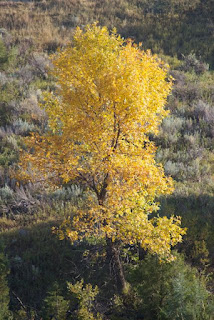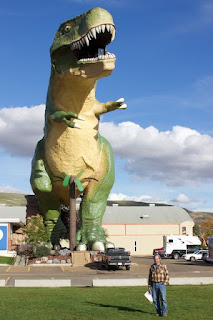 |
| A duck swims on Quill Lake alongside Grid Road 640 |
The Quill Lakes are a series of lakes in southeastern
Saskatchewan. Known as the Quills by
locals, these lakes are considered extraordinary because of their high saline
concentration. In the 1950s, Big Quill
Lake was three times more salty than an ocean.
This unique ecosystem in the midst of mixed grasslands is perfect for
migrating waterfowl.
During the spring and fall, nearly a million waterfowl visit
the Quills. This high concentration of water birds includes over 400,000 ducks,
130,000 snow geese, 80,000 Canada geese, 40,000 sandhill cranes, and 200,000
other kinds of shorebirds, including the rare piping plover. We came to the Quills to photograph these birds. I envisioned framing a blast-off, capturing
the moment when enormous numbers of snow geese fly out simultaneously for a day
of gleaning fields. I longed to hear the
thunder of their wings.
We did not find the concentration of waterfowl we expected
at the Quills. Instead we found an unexpected story and a community in crisis. Kyle, our guide at the
Wynyard Waterfowl Interpretive Center led us to a map showing Big Quill, Little
Quill, and Mud Lakes and told us that the map was no longer accurate. Because of extensive flooding since 2004,
these lakes have merged into one large lake. He explained the flooding has been exacerbated
because the Quills are a closed-basin system.
This means that during floods water runs in but does not run out,
causing water to spread out rapidly within the basin.
As a result of the flooding, mudflats and marshland have
been absorbed by the lakes, compromising feeding and nesting grounds. Nature trails and observation decks are now
underwater. We learned that migratory
waterfowl concentrations have become more spread out and fewer birds frequent
the area. He said that no one knows
where nesting piping plovers have gone.
Kyle told us that snow geese began arriving several
weeks earlier and suggested we may be able to photograph some along Grid Road
640.
He told us that we would encounter road closure signs but they were mostly
to discourage commercial vehicles. We
decided to take the drive to see what we could see.
Grid Road 640 is a 22-mile-long gravel road connecting
Wynyard to the Village of Quill Lake. At one time the road ran between the lakes, with Big Quill Lake on the western side of the road and Mud and Little Quill Lakes on the eastern side. Shortly
after we passed the road closure signs, we recognized that because of the
flooding the road had become a dike, essentially separating the now-one lake into two
sections. The wave action along the road
had deeply eroded its sides.
 |
| Fence rows barely visible in Quill Lake flooding |
As we drove, we encountered fence rows barely visible above
the water. Houses and barns were
diked. Farm equipment, as well as Canada geese, were stacked on
small islands. Ducks and coots swam
inches from the edge of the road.
A barricade with heavy concrete partitions crisscrossed the Grid 640 bridge. Weaving through the maze, we
could see water lapping at the top of the bridge. The boards beneath us creaked and groaned as
we crossed. The further we drove toward
the Village of Quill Lake, the more the water encroached around us.
 |
| Barricade on Grid Road 640 |
With few waterfowl in the area, we turned around and crossed the bridge again, slowing to a
stop to take photos. A man in a pickup hailed us and rolled down his window.
Lyle Thibault, a Quill Lake councilman and life-long resident of the area, had noticed our Texas tags and
was kind enough to stop to chat.
I told him, “You’ve got a huge problem here, Sir.”
He agreed and began telling us the Quill Lake story. “This is a not a 500-year flood. This is a 2,000-year event that we are
dealing with here.”
Mr. Thibault explained that during the past ten years,
excessive rainfall had caused the lakes to rise over 21 feet. As a result, 27,000 crop acres and 56,000
acres of pastureland were flooded. In the process, livelihoods and generational farms have been lost.
He lamented that the floods have changed everything. The environmental impact has been
devastating. Many birds have stopped
nesting or migrating to the area. Once these were considered to be dead lakes because of their excessive salinity. Now because the road is a dike between two halves of the lake, there is little mixing of the eastern side of the flood waters with the western side. As a result, the eastern side of Quill Lake has become so washed with fresh water that it can support freshwater fish like
the walleye.
He told us that the road we were driving has been raised
over three feet and reinforced with rock ballast along the sides to prevent
further erosion. Within the past week, the
community finished a project to install barricades and a concrete maze across
the bridge to prevent commercial traffic from further damaging the
structure. The bridge remains critical
to the road’s integrity and accessibility between the two towns. If it fails, the twenty-minute drive between
Wynyard and Quill Lakes will become over an hour long as drivers detour around. Thankfully, a portable bridge has been found
that will be placed over the top of the existing bridge within the next few
weeks. If excessive rain continues,
however, Grid Road 640, Highways 16 and 6, and a portion of the Canada Pacific
railway line may become impassable.
Mr. Thibault voiced concerns over attempts to manage the flooding. The Quill Lake basin is nearly full. Like a teacup with too much tea pouring into
it, the lake will soon begin spilling over, with much of it going to the southwest and into Last
Mountain Lake. If that happens, even more farmland, pastureland, and sensitive wetlands will be flooded along the way. Because of the salinity
of these floodwaters, fish and bird populations will be affected. Even if the water begins to recede, the salt may
permanently damage the farmland’s ability to be productive. Solutions are complex, costly, and none
satisfies every need. A dam proposal had
just been defeated. Petitions for
government assistance to displaced farmers and landowners have yet to be
approved. “It’s a catastrophic event,” Thibault
concluded.
 |
| An open gate to a field swamped by flood waters on Grid Road 640 |
We thanked Mr. Thibault for his time and wished him and his
constituents our best. Under heavy clouds and with a heavy heart, I stepped out of the
truck to take a photo of an open gate to a field swamped by flood waters. A large formation of snow geese came honking into view. As I watched them fly overhead, a misty rain began to fall.
 |
| Snow geese fly over Quill Lake |
If you would like to read more about the Quill Lake flooding, please check out these news articles...
- http://www.leaderpost.com/technology/Quill+Lakes+flooding+threat/11295125/story.html
- http://cjme.com/article/203110/salty-water-quill-lakes-flooding-farmland






















































